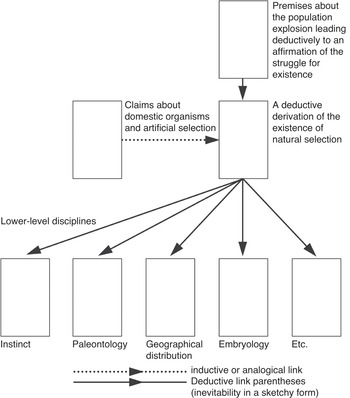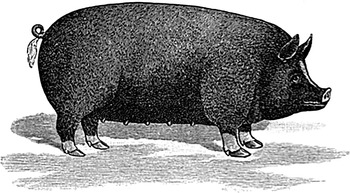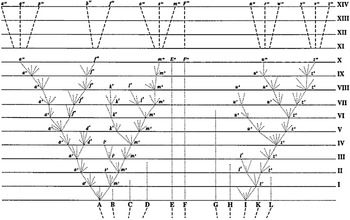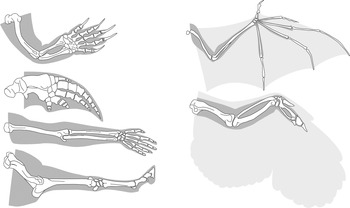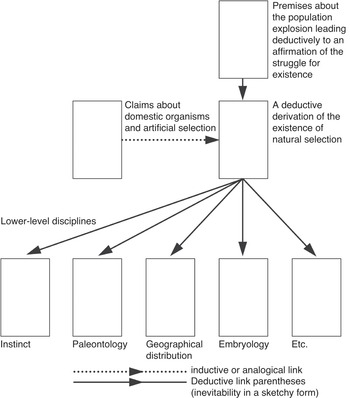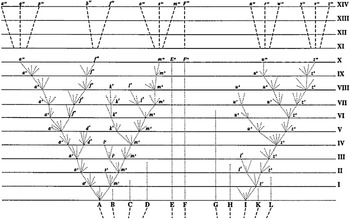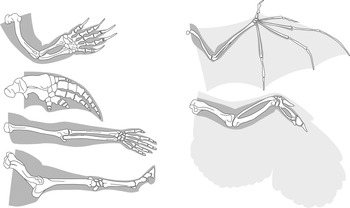On November 24, 1859, the English naturalist Charles Robert Darwin published On the Origin of Species by Means of Natural Selection, or the Preservation of Favoured Races in the Struggle for Life. In that book, he argued that all organisms, living and dead, were produced by a long, slow, natural process, from a very few original organisms. He called the process “natural selection,” later giving it the alternative name of “the survival of the fittest.” This first chapter is devoted to presenting (without critical comment) the argument of the Origin, very much with an eye to the place and role of natural selection. As a preliminary, it should be noted that the Origin, for all it is one of the landmark works in the history of science, was written in a remarkably “user-friendly” manner. It is not technical, the arguments are straightforward, the illustrative examples are relevant and easy to grasp, the mathematics is at a minimum, meaning non-existent. Do not be deceived. The Origin is also a very carefully structured piece of work. Darwin knew exactly what he was doing when he set pen to paper. It is easiest to regard the Origin as being (as Julius Caesar told us), like Gaul, divided into three parts: artificial selection, natural selection, consequences. We shall be guided by this division. Although Darwin was to describe the Origin as “one long argument,” later we shall see reason to think that Darwin himself would have been comfortable with our triune approach (Fig. 1.1).
A linguistic point as we plunge in. The term “evolution” had traditionally referred to the change of organisms as they individually develop: that is, “ontogeny.” It was only in the 1850s that the term came commonly to refer to change of organisms through time: “phylogeny”. Darwin had no strong objection to the term, and indeed the last word of the Origin is “evolved.” In later works he used it constantly. Usually in the Origin, though, he used terms like “descent with modification.” Somewhat anachronistically, since “evolution” is the term we use today, this is the term I shall use in this book.
Artificial Selection
The Industrial Revolution occurred in Britain in the second half of the eighteenth century and the first half of the nineteenth. Machines started to take over what previously had been done by hand, and this meant that people left the land and moved to cities, where factories housed the power-driven weaving looms producing cloth, where the furnaces for making metal goods blazed away, and where cheap mass-produced pottery could be fashioned from incoming loads of clay and other raw materials. But, to have an industrial revolution, you must at the same time have an agricultural revolution – more food for those in the factories, produced by fewer workers on the farms. It was realized that a key to such a revolution was selective breeding – fatter pigs, beefier cattle, shaggier sheep (Fig. 1.2 shows a pig bred for the market). Darwin came from Shropshire, in the heart of agricultural England, and he knew from the first that the key to success was picking the better specimens and breeding from them. It was almost preordained, therefore, that when his thoughts turned to evolution – organisms coming naturalistically from earlier, simpler forms – he was led first to human-driven organic change and its reasons. No surprise therefore that Chapter One of the Origin was devoted to selective breeding, both in the farmyard and by the fancier – pigeons, songbirds, fighting dogs.
Charles Darwin was ever a Lamarckian, meaning that (after the mechanism supposed by the French evolutionist Jean Baptiste de Lamarck) he accepted that change could come directly from forces on the individual organism; notably, he believed in the inheritance of acquired characteristics, where something like the blacksmith’s strong arms, the result of a lifetime at the forge, could be passed on directly to offspring. Lamarckism notwithstanding, it was selection that was the key force of change. Darwin focused in on pigeons, long a favorite of breeders, which came in many different varieties, some enough (by their looks) to be considered separate species. The key phrase is “by their looks.” Darwin thought that they came from the same source and were not indeed different species because they could still interbreed. What, then, had wrought the differences? “The key is man’s power of accumulative selection: nature gives successive variations; man adds them up in certain directions useful to him. In this sense he may be said to make for himself useful breeds” (Origin, 30). Not just pigeons either: all kinds of animals and plants. And note how the selection is for features desired by the breeders. They are of a kind that is useful or admired.
Youatt, who was probably better acquainted with the works of agriculturalists than almost any other individual, and who was himself a very good judge of an animal, speaks of the principle of selection as “that which enables the agriculturist, not only to modify the character of his flock, but to change it altogether. It is the magician’s wand, by means of which he may summon into life whatever form and mould he pleases.” Lord Somerville, speaking of what breeders have done for sheep, says:—”It would seem as if they had chalked out upon a wall a form perfect in itself, and then had given it existence.” That most skilful breeder, Sir John Sebright, used to say, with respect to pigeons, that “he would produce any given feather in three years, but it would take him six years to obtain head and beak.”
Natural Selection
Human-caused change having been introduced, including what Darwin called “unconscious selection,” where change occurs without the intent of the breeder – in other words, change without a mind directing the change – he then moved on (in Chapter Two) to the natural world. This took him into the second part of his overall argument, first establishing that in populations of organisms there is always a deal of variation – bigger, smaller, faster, slower, sturdier, more fragile.
No one supposes that all the individuals of the same species are cast in the very same mould. These individual differences are highly important for us, as they afford materials for natural selection to accumulate, in the same manner as man can accumulate in any given direction individual differences in his domesticated productions.
Darwin, like others, had little knowledge of the sources of such variation, but an eight-year study of barnacles had convinced him that it always exists. Important was his conviction that, however caused, such variation never seems to satisfy needs. In this sense it is “random.” Second, preparing the way for evolution, Darwin argued that natural populations differ, but how much they differ is in a sense arbitrary. The difference could be small, it could be big. Indeed, it is often unclear where a variety ends and a species begins. “I look at the term species, as one arbitrarily given for the sake of convenience to a set of individuals closely resembling each other, and that it does not essentially differ from the term variety, which is given to less distinct and more fluctuating forms” (Origin, 52). In other words, no need to assume major jumps – “saltations.” Causes could and probably do bring on gradual change.
Now, in Chapters Three and Four, Darwin was ready for the heavy-duty arguments that lead to the causal forces of change. First, the “Struggle for Existence.” At the end of the eighteenth century, there was already a major population explosion, which only intensified as the nineteenth century got underway. London, for instance, grew from about three-quarters of a million inhabitants in the middle of the eighteenth century to about a million and a half inhabitants by 1815. By 1860, the population was over three million. This growth in major part was brought on by the move to industrialism, where children (because they could work the machines) came early and frequently, as opposed to rural life where children were often postponed until family farms could be inherited.
However, the Anglican parson Thomas Robert Malthus was able to reassure people that this could not go on indefinitely. Population numbers increase geometrically – 1, 2, 4, 8, 16… – whereas food and space increase only arithmetically – 1, 2, 3, 4, 5…. There is going to be a crunch, and only some can survive – or, more significantly, contribute offspring to the next generation. The produce of the Earth
… may increase for ever and be greater than any assignable quantity; yet still the power of population being in every period so much superior, the increase of the human species can only be kept down to the level of the means of subsistence by the constant operation of the strong law of necessity, acting as a check upon the greater power.
Darwin incorporated this argument in its entirety into his theory.
A struggle for existence inevitably follows from the high rate at which all organic beings tend to increase. Every being, which during its natural lifetime produces several eggs or seeds, must suffer destruction during some period of its life, and during some season or occasional year, otherwise, on the principle of geometrical increase, its numbers would quickly become so inordinately great that no country could support the product. Hence, as more individuals are produced than can possibly survive, there must in every case be a struggle for existence, either one individual with another of the same species, or with the individuals of distinct species, or with the physical conditions of life.
Darwin used this argument as the springboard for a cause that produces indefinite change. Only a few getting through to the next generation is a natural equivalent of the breeder’s method of producing change.
HOW will the struggle for existence, discussed too briefly in the last chapter, act in regard to variation? Can the principle of selection, which we have seen is so potent in the hands of man, apply in nature? I think we shall see that it can act most effectually. Let it be borne in mind in what an endless number of strange peculiarities our domestic productions, and, in a lesser degree, those under nature, vary; and how strong the hereditary tendency is. Under domestication, it may be truly said that the whole organisation becomes in some degree plastic. Let it be borne in mind how infinitely complex and close-fitting are the mutual relations of all organic beings to each other and to their physical conditions of life. Can it, then, be thought improbable, seeing that variations useful to man have undoubtedly occurred, that other variations useful in some way to each being in the great and complex battle of life, should sometimes occur in the course of thousands of generations? If such do occur, can we doubt (remembering that many more individuals are born than can possibly survive) that individuals having any advantage, however slight, over others, would have the best chance of surviving and of procreating their kind? On the other hand, we may feel sure that any variation in the least degree injurious would be rigidly destroyed. This preservation of favourable variations and the rejection of injurious variations, I call Natural Selection.
An important point here and a codicil. The point is that – something we shall later see caused much angst – although individual variations may appear randomly, selection-driven change is not random. It is in the direction of “useful” features or characteristics. Remember: “It would seem as if they had chalked out upon a wall a form perfect in itself, and then had given it existence.” For the breeder, the features are those he or she wants – shaggier sheep or more melodious songbirds. In nature, the features are those that the possessor needs to outlive (out-reproduce) competitors: “adaptations.”
We see these beautiful co-adaptations most plainly in the woodpecker and missletoe; and only a little less plainly in the humblest parasite which clings to the hairs of a quadruped or feathers of a bird; in the structure of the beetle which dives through the water; in the plumed seed which is wafted by the gentlest breeze; in short, we see beautiful adaptations everywhere and in every part of the organic world.
The codicil is that there is a secondary form of selection: sexual selection. Guided in his thinking by the fact that breeders select, on the one hand, for useful features like porkier pigs, and, on the other hand, for attractive features like more beautiful tail feathers, Darwin supposed that there is natural selection, producing adaptations for living, and sexual selection, producing adaptations useful towards the end of mate-attraction. “This depends, not on a struggle for existence, but on a struggle between the males for possession of the females; the result is not death to the unsuccessful competitor, but few or no offspring.” He continues: “in many cases, victory will depend not on general vigour, but on having special weapons, confined to the male sex. A hornless stag or spurless cock would have a poor chance of leaving offspring” (Origin, 88).
After a couple of very brief hypothetical examples of how natural selection might be expected to work – Darwin instanced wolves chasing prey, deer, who would be under selective pressure to be slim, no excess weight to carry, and fast, able to outrun their victims – he rushed along to the implications of the second part of his argument. Here Darwin relied on what the eighteenth-century Scottish political economist Adam Smith in 1776 had called a “division of labour.” Things will work far more efficiently if everyone does their own specialized job rather than attempting to be a jack of all trades. In nature, if organisms specialize, they will do better than otherwise: “the more diversified the descendants from any one species become in structure, constitution, and habits, by so much will they be better enabled to seize on many and widely diversified places in the polity of nature, and so be enabled to increase in numbers” (Reference DarwinDarwin 1859, 112). This will lead eventually to many different species, all using their specific adaptations to succeed in the niches that they inhabit. And so, ultimately, we will get evolution. The fact of evolution. Using a metaphor that was there from the moment that Darwin became an evolutionist, we get a “tree of life” (Fig. 1.3 shows a sketch Darwin drew in a notebook, early in 1838).
The affinities of all the beings of the same class have sometimes been represented by a great tree. I believe this simile largely speaks the truth. The green and budding twigs may represent existing species; and those produced during each former year may represent the long succession of extinct species. At each period of growth all the growing twigs have tried to branch out on all sides, and to overtop and kill the surrounding twigs and branches, in the same manner as species and groups of species have tried to overmaster other species in the great battle for life.
He continues:
As buds give rise by growth to fresh buds, and these, if vigorous, branch out and overtop on all sides many a feebler branch, so by generation I believe it has been with the great Tree of Life, which fills with its dead and broken branches the crust of the earth, and covers the surface with its ever branching and beautiful ramifications.
The second part of the Origin now completed, Darwin had a couple of linking, albeit somewhat desultory, discussions (Chapters Five and Six), where he talked a little about the nature and possible causes of variation and looked at some possible objections towards what he had thus far argued. What is of interest (and subsequent importance) is a clarification at the end of Chapter Six. Darwin stressed that he did not think that all aspects of an organism necessarily must be adaptive, and he drew attention to something known to Aristotle, namely that there are isomorphisms (structural similarities; what Darwin’s contemporary, the anatomist Richard Owen, in 1843 had called “homologies”) between organisms of different kinds (Fig. 1.5). Using the terms “unity of type” (homology) and “conditions of existence” (adaptation), Darwin wrote:
It is generally acknowledged that all organic beings have been formed on two great laws—Unity of Type, and the Conditions of Existence. By unity of type is meant that fundamental agreement in structure, which we see in organic beings of the same class, and which is quite independent of their habits of life. On my theory, unity of type is explained by unity of descent. The expression of conditions of existence, so often insisted on by the illustrious Cuvier, is fully embraced by the principle of natural selection. For natural selection acts by either now adapting the varying parts of each being to its organic and inorganic conditions of life; or by having adapted them during long-past periods of time: the adaptations being aided in some cases by use and disuse, being slightly affected by the direct action of the external conditions of life, and being in all cases subjected to the several laws of growth. Hence, in fact, the law of the Conditions of Existence is the higher law; as it includes, through the inheritance of former adaptations, that of Unity of Type.
The importance of this passage becomes clearer as the Origin proceeds. On the one hand, the primacy of natural selection, and consequent adaptation, is affirmed; on the other hand, the isomorphisms between organisms widely different are acknowledged. This latter is important because, as Darwin knew full well from his work on barnacles, such isomorphisms or homologies are the key to ferreting out distant relationships and lines of descent: “phylogenies.”
We now move (across more than half the length of the Origin) to the third part of Darwin’s long argument. Darwin surveyed the various areas of the life sciences, showing how evolution through natural selection could explain much, and how, also, the explanations reflected back up to the causal mechanism of selection, confirming its existence and power. He started (his Chapter Seven) with behavior: “Instinct.” Actually, it was not just behavior that interested Darwin but social behavior in particular. How do insects like the hymenoptera (ants, bees, wasps) function so harmoniously together? One thing that attracted his attention was the existence of sterile workers. He argued that, analogously to the farm, where sterile animals like the (castrated) ox can be improved by going back to the parent stock and breeding from those that have desirable offspring, so in the nest those fertile insects that have more and more efficient sterile offspring will be naturally selected.
This difficulty, though appearing insuperable, is lessened, or, as I believe, disappears, when it is remembered that selection may be applied to the family, as well as to the individual, and may thus gain the desired end. Thus, a well-flavoured vegetable is cooked, and the individual is destroyed; but the horticulturist sows seeds of the same stock, and confidently expects to get nearly the same variety; breeders of cattle wish the flesh and fat to be well marbled together; the animal has been slaughtered, but the breeder goes with confidence to the same family.
Darwin continued:
Thus I believe it has been with social insects: a slight modification of structure, or instinct, correlated with the sterile condition of certain members of the community, has been advantageous to the community: consequently the fertile males and females of the same community flourished, and transmitted to their fertile offspring a tendency to produce sterile members having the same modification.
Not just sterile workers, but sterile workers of different castes:
I believe that natural selection, by acting on the fertile parents, could form a species which should regularly produce neuters, either all of large size with one form of jaw, or all of small size with jaws having a widely different structure; or lastly, and this is our climax of difficulty, one set of workers of one size and structure, and simultaneously another set of workers of a different size and structure;—a graduated series having been first formed, as in the case of the driver ant, and then the extreme forms, from being the most useful to the community, having been produced in greater and greater numbers through the natural selection of the parents which generated them; until none with an intermediate structure were produced.
We move next (Chapter Eight) to “Hybridism.” The main aim here was to show that, when it comes to questions of sterility, as one might expect from an evolutionary perspective (and primed by the discussion in Chapter Two), varieties slide in a more-or-less-gradated way into species – hybrids fertile, to hybrids less-than-fertile, to hybrids sterile. Natural selection does not play a big role in this discussion, but its importance picks up again as we turn to Chapters Nine and Ten on geology, and the nature and significance of fossils (Fig. 1.6 shows the fossil record as known at the time of the Origin, from Reference OwenRichard Owen’s 1860 Palaeontology). What did not worry Darwin was the needed time for evolutionary change. In his mind, that battle was over. “It is hardly possible for me even to recall to the reader, who may not be a practical geologist, the facts leading the mind feebly to comprehend the lapse of time” (Origin, 282). We are talking millions – probably hundreds of millions – of years here.

Figure 1.6 The fossil record as drawn by Owen in his Palaeontology (Reference Owen1860).
This given, there are still worries. Significantly, the first part of the chapter finds Darwin on his back foot, defending his theory against the charge that, because we do not find a smooth gradation of forms as we might expect if evolution through natural selection is the chief causal factor, it cannot be true. “Why then is not every geological formation and every stratum full of such intermediate links? Geology assuredly does not reveal any such finely graduated organic chain; and this, perhaps, is the most obvious and gravest objection which can be urged against my theory. The explanation lies, as I believe, in the extreme imperfection of the geological record” (Origin, 280). Ever inventive, ever persuasive, Darwin gave explanations backing this claim. Even he, though, admitted that some problems could not, at the moment, be solved. Most worrisome of all was that fairly sophisticated organisms just appeared in the fossil record, at the lowest levels, meaning the earliest times. Before that, nothing:
… if my theory be true, it is indisputable that before the lowest Silurian stratum was deposited, long periods elapsed, as long as, or probably far longer than, the whole interval from the Silurian age to the present day; and that during these vast, yet quite unknown, periods of time, the world swarmed with living creatures.
To the question why we do not find records of these vast primordial periods, I can give no satisfactory answer.
Not all is gloom and doom, starting with the fact that the fossil record as it was suggested evolution. “New species have appeared very slowly, one after another, both on the land and in the waters.” What was eye-catching was the way that as we go back in time, older organisms seemed to link up forms very different today – which is as we would expect given evolution. “It is a common belief that the more ancient a form is, by so much the more it tends to connect by some of its characters groups now widely separated from each other” (Origin, 330). Of course, this is not universally true. “Yet if we compare the older Reptiles and Batrachians, the older Fish, the older Cephalopods, and the eocene Mammals, with the more recent members of the same classes, we must admit that there is some truth in the remark” (Origin, 330–1). What is exciting is the claim “that ancient animals resemble to a certain extent the embryos of recent animals of the same classes; or that the geological succession of extinct forms is in some degree parallel to the embryological development of recent forms.” Darwin claimed not to be entirely convinced of the truth of this claim: “Yet I fully expect to see it hereafter confirmed, at least in regard to subordinate groups, which have branched off from each other within comparatively recent times” (Origin, 338). He added that he would have more to say in a later chapter (Chapter Thirteen), where he would spell out how adaptations might be added at a later stage of individual development (ontogeny; as opposed to phylogeny, group development), and so the early forms would remain the same, even as newer forms retained the early forms while embryos and then went on to differ as the adults.
Starting now to warm to his themes, in Chapters Eleven and Twelve Darwin took on the facts of geographical distribution. He was not keen on the idea that different species were created from scratch in situ around the globe. He thought this highly improbable. “Nevertheless the simplicity of the view that each species was first produced within a single region captivates the mind. He who rejects it, rejects the vera causa of ordinary generation with subsequent migration, and calls in the agency of a miracle” (Origin, 352). Much space was devoted, again, to arguing against problems, here particularly how organisms could have moved naturally over long distances, often including travel over vast oceans. Then comes the positive case: ocean islands.
The most striking and important fact for us in regard to the inhabitants of islands, is their affinity to those of the nearest mainland, without being actually the same species. Numerous instances could be given of this fact. I will give only one, that of the Galapagos Archipelago, situated under the equator, between 500 and 600 miles from the shores of South America. Here almost every product of the land and water bears the unmistakeable stamp of the American continent.
How could this possibly be, save through evolution?
Why should this be so? why should the species which are supposed to have been created in the Galapagos Archipelago, and nowhere else, bear so plain a stamp of affinity to those created in America? There is nothing in the conditions of life, in the geological nature of the islands, in their height or climate, or in the proportions in which the several classes are associated together, which resembles closely the conditions of the South American coast: in fact there is a considerable dissimilarity in all these respects.
The clincher, if one be needed, is that the denizens of the islands are similar, but different. There were original invaders, who then moved from island to island and diversified.
Moving along now rapidly towards the conclusion, Chapter Thirteen covers classification, morphology, embryology, and rudimentary organs. Classification, based on the Linnaean system, links organisms in ever broader groups – the organism is a member of a species, which then is grouped with species with similar organisms into genera (the plural of “genus”), and so all the way up to kingdoms. The reason? Evolution through natural selection. In truth, “natural selection, which results from the struggle for existence, and which almost inevitably induces extinction and divergence of character in the many descendants from one dominant parent-species, explains that great and universal feature in the affinities of all organic beings, namely, their subordination in group under group” (Origin, 433). Morphology, the anatomical nature of organisms, is (as we anticipated earlier) likewise explained by Darwinian theory. Most significant is what we have seen Owen calling “homologies,” the isomorphisms between different animals. There is no point to them. They serve no function. Using language we shall explore later, they have no “final causes.”
Nothing can be more hopeless than to attempt to explain this similarity of pattern in members of the same class, by utility or by the doctrine of final causes. The hopelessness of the attempt has been expressly admitted by Owen in his most interesting work on the ‘Nature of Limbs.’ On the ordinary view of the independent creation of each being, we can only say that so it is;—that it has so pleased the Creator to construct each animal and plant.
So why the similarities? What is the significance of homology? “The explanation is manifest on the theory of the natural selection of successive slight modifications—each modification being profitable in some way to the modified form, but often affecting by correlation of growth other parts of the organisation. In changes of this nature, there will be little or no tendency to modify the original pattern, or to transpose parts.” Reverting again to Owen’s view of things, Darwin says: “If we suppose that the ancient progenitor, the archetype as it may be called, of all mammals, had its limbs constructed on the existing general pattern, for whatever purpose they served, we can at once perceive the plain signification of the homologous construction of the limbs throughout the whole class” (Origin, 435).
Figure 1.7 shows Owen’s archetype.
Embryology was a favorite of Darwin. Why is it that, picking up on a question left dangling earlier, very different adult organisms so often have very similar embryos? It is simply because the embryos in the egg or the womb are not much affected by natural selection responding to changed circumstances, but as the embryos grow, natural selection gets to work. Moreover: “As the embryonic state of each species and group of species partially shows us the structure of their less modified ancient progenitors, we can clearly see why ancient and extinct forms of life should resemble the embryos of their descendants,—our existing species” (Origin, 449).
And so, after a quick look at rudimentary organs – the flotsam and jetsam of the evolutionary process – we are ready for Chapter Fourteen: “Recapitulation and Conclusion.” Missing thus far in the argumentation of the Origin has been our own species. It remains missing except for a glancing reference. “Light will be thrown on the origin of man and his history” (488). And then the climax – the most famous passage in the whole of science.
It is interesting to contemplate an entangled bank, clothed with many plants of many kinds, with birds singing on the bushes, with various insects flitting about, and with worms crawling through the damp earth, and to reflect that these elaborately constructed forms, so different from each other, and dependent on each other in so complex a manner, have all been produced by laws acting around us. These laws, taken in the largest sense, being Growth with Reproduction; Inheritance which is almost implied by reproduction; Variability from the indirect and direct action of the external conditions of life, and from use and disuse; a Ratio of Increase so high as to lead to a Struggle for Life, and as a consequence to Natural Selection, entailing Divergence of Character and the Extinction of less-improved forms. Thus, from the war of nature, from famine and death, the most exalted object which we are capable of conceiving, namely, the production of the higher animals, directly follows. There is grandeur in this view of life, with its several powers, having been originally breathed into a few forms or into one; and that, whilst this planet has gone cycling on according to the fixed law of gravity, from so simple a beginning endless forms most beautiful and most wonderful have been, and are being, evolved.


